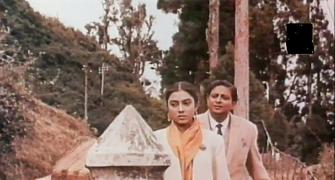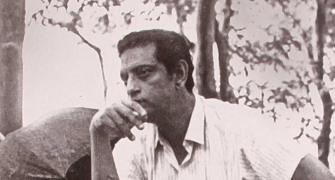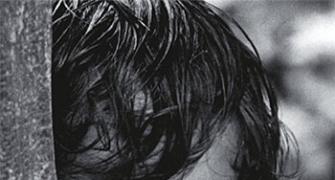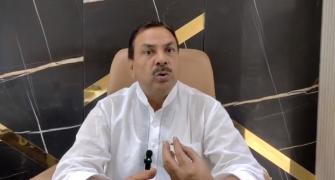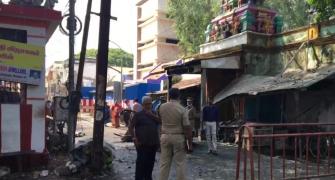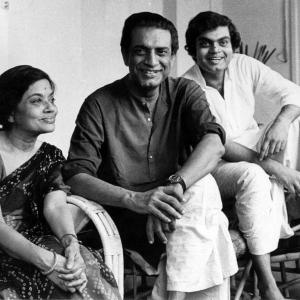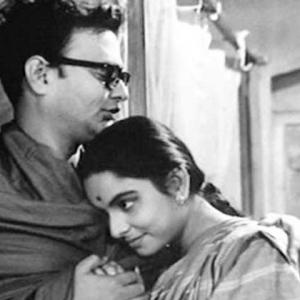'Where Pratidwandi is concerned, there are very few men standing.'

Dhritiman Chatterjee, a post-graduate in economics, came from a world outside of cinema, yet made an impressive debut in the first film in Satyajit Ray's Calcutta trilogy,Pratidwandi.
He played Siddhartha Chaudhuri, forced by his father's sudden demise to quit his studies and hit the streets of Kolkata in search of a job that eludes him.
Unwilling to compromise like his sister or be radicalised by Left politics like his brother, Siddhartha eventually leaves the city to settle for a future with perhaps no ambitions or aspirations.
Surprisingly, even though Siddhartha Chaudhuri is more of a passive spectator than a raging crusader and explodes just once, Dhritiman Chatterjee was typed as the urban, angry, young man, a tag he has shrugged off in the five decades since.
Speaking to Rediff.com Senior Contributor Roshmila Bhattacharya, the actor rewinds to his first tryst with the camera as the digitally restored Pratidwandi gears up for screening at the 75th Cannes film festival.
"My performance was well received and Ray's gamble of casting a first-time actor -- even a non-actor in the sense that after Pratidwandi, I went back to working outside of cinema -- paid off," Chatterjee says, long distance from Goa, where he has a second home, admitting that he would have been happy to present the cult film at Cannes.
What were the reactions to Pratidwandi when it was released on October 27, 1970?
Well, it was a long time ago -- 52 years to be precise -- but I recall that family, friends and even the general public sat up and took notice because it was a very different film for Satyajit Ray.
Stylistically, it was a departure from his usual classical style, far more technical with freezes, jump cuts and hand-held camera shots.
Those familiar with international cinema would know these filming techniques from French New Wave which predated Pratidwandi.
Subject wise too, it was more contemporary. Ray, who usually left it to the audience to draw their own conclusions, said things far more clearly, making a statement by juxtaposing the two brothers.
My performance was well received and Ray's gamble of casting a first-time actor -- even a non-actor in the sense that after Pratidwandi, I went back to working outside of cinema -- paid off.

Even though you were a debutant, you lived the role of Siddhartha. Was it because you could personally relate to the political milieu in Bengal during the turbulent late 1960s and early 1970s?
As an undergraduate studying economics at Kolkata's Presidency College in the late sixties, I could see the beginning of this political turbulence as a number of my classmates veered towards extreme Left politics.
I held a post in the college union so there was some involvement with politics on my part but while I had my views on the subject, I was never very active politically.
With exams getting disrupted and results delayed -- a chronic problem with Calcutta University -- I decided to pursue my postgraduate studies at the Delhi School of Economics, hoping the process would be smoother there. And it was.
Delhi University had a rich and serious theatre tradition. I got interested and that was the beginning of my acting career.
After completing my education, I returned to Kolkata and started working with a reputed British company where, once again, I was exposed to politics in my dealings with one of the workers's unions which was quite left-of-centre and involved with strikes.
My personal equation with the workers was cordial and we would discuss politics in the middle of the disruptions.
Kolkata at that time was going through rough times, with some killings, industries moving out and a severe power shortage; it was dark days for the city and the state.
At the time did you ever think, like Siddhartha, of leaving the city?
No, that thought did not occur to me at all.
Even when I went to Delhi earlier, it was only for education; I was enjoying my stay in Kolkata.
It was much later, when I was married and had started a family that, for reasons not relevant to this conversation, we decided to move to Chennai.
Then, seven to eight years ago, we got ourselves a second home in Goa.
But there was nothing remotely similar between my going away and Siddhartha's.
Interestingly, in the late eighties, after Ganashatru, I did this really long, non-cinema, interview with Ray during which we discussed politics, the state of the city, even spiritualism.
When the subject of Kolkata in the early seventies came up, he admitted that, even during those dark times, the thought of leaving Kolkata and making films elsewhere had never occurred to him.
Kolkata was his inspiration; he didn't think he would have found that inspiration elsewhere.
So he stayed and, with Seemabaddha following Pratidwandi a year later, and Jana Aranyam in 1976, he completed his powerful Calcutta trilogy.

Given the political turbulence, social disruptions, growing unemployment and disillusionment, and the subsequent migration, isn't Kolkata today a lot like what it was in the 1970s?
Let me start by saying that I love Kolkata, it's in my blood and, in spite of all the problems, I'm always happy to be back.
For me, it's a warm and cordial city, accepting of outsiders, which makes it such a multilingual, multicultural place.
At any point of time, no matter which government is in power and what their political and ideological orientation is, there's always so much happening.
Yes, in the seventies, when I was involved with the industrial and corporate world, I noticed the migration.
Even today, qualified young people are moving out in pursuit of brighter prospects. At the same time, of late, Kolkata seems to be changing and getting economically stronger.
The Salt Lake area where we live looks better and cleaner. It's not just me; others not from the city are saying this too.
Let's flashback to your first meeting with Ray...
That was when I was studying at the Delhi School of Economics.
A group of us had started the first film society there and, wanting to bring out a magazine, attempted to get in touch with film-makers like Ray, Shyam Benegal and Santi Chaudhury.
This was in the late sixties and getting through to someone on the phone was exceedingly difficult.
When I finally managed to connect with Ray, he asked me to come and see him. During one of my visits to Kolkata, I called on him, not with the idea of acting in a film, but to request a piece for the magazine.
He was leaving for a film festival and asked me to get in touch on his return.
That didn't happen as the magazine never came out.
Much later, when I was back in Kolkata, a friend who was a part of Ray's extended family and lived in 172/3, a building on Rashbehari Avenue from where his Bengali children's magazine Sandesh was published, told me that he was looking for a newcomer to play the protagonist in his next film.
I went to meet him, again not with the objective of becoming a film star and making a career in acting, but because I was interested in film-making.
I thought that if I bagged the role, I would get an opportunity to observe Ray at work.
We spoke a lot. Then, he gave me a screen test where he made me read a scene and I ended up playing Siddhartha.

You did two more films with him, Ganashatru in 1989, and his last film, Agantuk in 1991. Was the Ray in later years different from the one who had mentored you in Pratidwandi?
There was a large gap between these films and he was definitely older by the time he started Ganashatru.
Also, he had gone through a severe illness so there was an ambulance standing outside the set all the time and his cardiologist dropped by frequently.
During Pratidwandi, he used to run through the streets of Kolkata. This time he deliberately chose to adapt Henrik Ibsen's play An Enemy of the People because it had very little outdoors.
He was no longer operating the camera, but the basic attributes of his film-making had not changed.
He was still attentive to the smallest detail, be it appearance or costumes.
And Agantuk?
That was just a two-scene appearance, I shot just three-four days, so there weren't too many opportunities to observe him.
At that time, if anyone else had offered me two scenes, I'd probably have turned them down. But this was Ray! When he asked to come down so he could tell me about the film, I went happily.
The idea was for him to narrate only those two scenes, but, in his unbridled enthusiasm, he narrated the entire story, giving me the background and how he saw Utpal Dutt's character.
It's incredible how these films are still so relevant today.
That's because Ray was always a socially conscious film-maker and, while understated, definitely a political film-maker.

You agree, then, that restoring classics like Pratidwandim is a great way of not just extending their shelf life, but also bringing them to the younger generation?
Yes. It is important to restore and preserve timeless films like Pratidwandi and G Aravindan's digitally restored Thampi, which will also be screened in the Classics section at Cannes this year, for future generations.
As a member of the Ray Society, we are also digitising a lot of print -- his manuscripts, screenplays, essays -- for posterity.
Did you get an invitation to the Pratidwandi screening at Cannes?
No, and there has been some flutter about it in the press.
I was informed by the National Film Archives of India that a restored print in sparkling 4K resolution will be screened at Cannes.
I know India is the 'County of Honour' and an Indian delegation, headed by Union Minister of Information & Broadcasting Anurag Thakur, will be at the festival.
I don't know the protocol -- who should do the inviting, Cannes or the Indian government?
Logically, the first person to be invited should have been the producer (Purnima Dutta) but she has not got an invitation.
I would have loved to present the film at Cannes; where Pratidwandi is concerned, there are very few men standing.
Why don't we see you in more films today?
I'm not getting any younger and Goa is a wonderful place to lead a semi-retired life.
I continue to work on projects worth my time.
They don't have to necessarily be lead roles; since the nineties, I have changed my criterion for doing a film.
I've expanded my range to include more diverse roles, play different people, even if I didn't get much screen time.
Earlier in my career, I was labelled an urban angry young man; these days I enjoy playing rural characters.
A couple of months ago, I completed a film based on a well-known Bengali novel in which I play a village priest.
Apart from acting, I'm informally mentoring some young and talented film-makers.
I also love travelling.
Basically, I'm trying to enjoy life.


